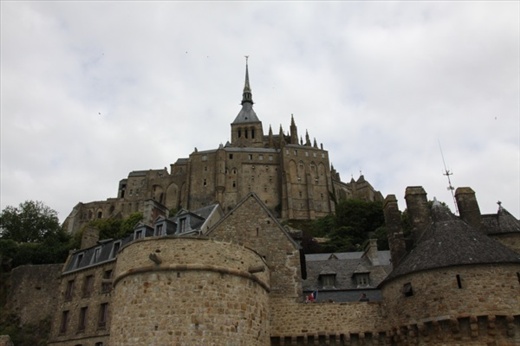We are in the final days of our clockwise circumnavigation of Paris by visiting several World Heritage sites a day. It’s a lot of driving but we are having a great time. First stop, Mont St. Michel.

Rising 250 feet out of the bay, Mont St. Michel combines a Romanesque church with Gothic overtones and the feel of a medieval town and abbey. Most of all it’s a tourist trap – but a picturesque one. It is much nicer when seen from afar across the meadows with grazing sheep and cows. As you get nearer, the car park and dozens of tour buses dominate the view. One narrow medieval street climbs and climbs past souvenir shops and eight hotels hidden in the labyrinth of alleyways until it reaches the church. The best time to see Mont St. Michel is when it is illuminated at night and surrounded by water on a spring tide. As it happened, we were there at noon on low tide. We arrived just after several tour buses so it was too crowded to really enjoy but we had great views from a nearby windmill where we ate our lunch.
Le Havre is the least likely World Heritage Site imaginable. My first impression was of Elizabeth, NJ but once we passed the refineries and storage tanks the air cleared enough to see the modern, ordinary city. The port city was occupied by German troops early in the war and the Allies bombed it unmercifully every chance they got so it was entirely rebuilt after the war. Other than cheap gas we couldn’t find a reason to linger.
Claude Monet is our favorite painter so we stopped to see the Cathedral of Rouen, even if it isn’t a World Heritage site. Monet had the time to make 30 paintings of the cathedral in various light conditions but we were there at the worst time, just after noon. The church steeple is under renovation, just a steel skeleton and scaffolding obscures the front of the church. A tree completely blocks the view from where he painted. But Claude stood there, we stood there and the circle is completed.
We gave up after an hour of trying to figure out Amiens. The architecture is strange, parking seemingly non-existent and the hotels are either expensive or elusive so we headed out of town towards Beauvais. We hadn’t gone far when we noticed a sign for a “Chambre de Cote” French for B&B. We found L’herbe du Grace three kilometers down the road in the hamlet of Pechy. After ringing the bell several times I was greeted by Gil, the owner. He was in his underwear and his hairy shoulders looking like sprouting feathers. He and his wife speak no English but Gil was undaunted and rambled on in French. Yes, they had a room. Fifty-seven euros. Breakfast at 8:30. Would we have coffee, chocolate or tea? We could find dinner about 7 km down the road. He would close the gate at seven but we didn’t need a key to open it. Just shut it again, s’il vous plait. The room key is in the door. There was something else about an Australian that I didn’t catch.
The “room” is in the gabled attic above their quarters, all hand-hewn beams pegged together centuries ago. People were shorter then so mind your head! The sleeping area is large and tastefully decorated in eclectic farmhouse style. In addition to the queen bed we have a day bed, some plants, a bookcase, desk, chairs and even a foot-treadle sewing machine. There is also a sitting area and a small kitchenette with a fridge and an en-suite bathroom. This was a wonderful experience and we will certainly look for more when we return to France.
Amien, we learned, had been badly shelled during WW I, hence the strange looking buildings. But the cathedral was the epitome of Gothic architecture, “Gothic done right.” I don’t know the architectural terms but everything just seems to work.
Only one more stop before we dropped off the car. The Basilica of St. Denis is considered the first example of Gothic art and the first use of the slender “flying buttress,” which both supported the roof and allowed light to enter through huge windows. It was a major part of Ken Follett’s Pillars of Stone, which we just read and we wanted to see it. It is diminutive compared to some of the cathedrals we have seen, but no less important.